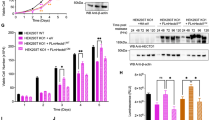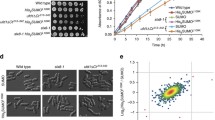Abstract
Protein phosphotase Cdc14 (Cell division cycle gene 14) is a key regulator of late mitotic events in Saccharomyces cerevisiae. However the function of human Cdc14 (HsCdc14A & B) and its regulatory network are still elusive. In this study, we identified a new partner of HsCdc14A named Brap2 (BRCA1 associated protein 2) using yeast two-hybrid screening assay. The interaction between these two proteins is confirmed by co-immunoprecipitation in human HEK 293T cells. Brap2 co-localizes with HsCdc14A on mitotic spindle poles and over-expression of Brap2 causes multiple spindle poles. Furthermore, we found that Brap2, which has intrinsic RING domain dependent E3 ligase activity, facilitates HsCdc14A Lys-63 linked ubiquitin modification, indicating that Brap2 may be the ubiquitin E3 Ligase of HsCdc14A. Our findings imply that Brap2 plays a significant role in cell cycle regulation besides its facilitation of HsCdc14A ubiquitination.



Similar content being viewed by others
References
Asada M, Ohmi K, Delia D et al (2004) Brap2 functions as a cytoplasmic retention protein for p21 during monocyte differentiation. Mol Cell Biol 24:8236–8243
Cho HP, Liu Y, Gomez M et al (2005) The dual-specificity phosphatase CDC14B bundles and stabilizes microtubules. Mol Cell Biol 5:4541–4551
Kaiser BK, Zimmerman ZA, Charbonneau H et al (2002) Disruption of centrosome structure, chromosome segregation, and cytokinesis by mis-expression of human Cdc14A phosphatase. Mol Biol Cell 13:2289–2300
Li L, Ernsting BR, Wishart MJ et al (1997) A family of putative tumor suppressors is structurally and functionally conserved in humans and yeast. J Biol Chem 272:29403–29406
Li S, Ku CY, Farmer AA et al (1998) Identification of a novel cytoplasmic protein that specifically binds to nuclear localization signal motifs. J Biol Chem 273:6183–6189
Li L, Ljungman M, Dixon JE (2000) The human Cdc14 phosphatases interact with and dephosphorylate the tumor suppressor protein p53. J Biol Chem 275:2410–2414
Lou Y, Yao J, Zereshki A et al (2004) Nek2A interacts with Mad1 and possibly functions as a novel integrator of the spindle checkpoint signaling. J Biol Chem 279:20049–20057
Mailand N, Lukas C, Kaiser BK et al (2002) Deregulated human Cdc14A phosphatase disrupts centrosome separation and chromosome segregation. Nat Cell Biol 4:317–322
Matheny SA, Chen C, Kortum RL et al (2004) Ras regulates assembly of mitogenic signalling complexes through the effector protein IMP. Nature 427:256–260
Paulsen MT, Starks AM, Derheimer FA et al (2006) The p53-targeting human phosphatase HsCdc14A interacts with the Cdk1/cyclin B complex and is differentially expressed in human cancers. Mol Cancer 5:25
Pickart CM (2002) Ubiquitin in chains. Trends Biochem Sci 25:544–548
Sun L, Chen ZJ (2004) The novel functions of ubiquitination in signaling. Curr Opin Cell Biol 16:119–126
Urushitani M, Kurisu J, Tateno M et al (2004) CHIP promotes proteasomal degradation of familial ALS-linked mutant SOD1 by ubiquitinating Hsp/Hsc70. J Neurochem 90:231–244
Vázquez-Novelle MD, Esteban V, Bueno A et al (2005) Functional homology among human and fission yeast Cdc14 phosphatases. J Biol Chem 280:29144–29150
Vong QP, Cao K, Li HY et al (2005) Chromosome alignment and segregation regulated by ubiquitination of surviving. Science 310:1499–1504
Yuan K, Hu H, Guo Z et al (2007) Phospho-regulation of HsCdc14A by polo-like kinase 1 is essential for mitotic progression. J Biol Chem 282:27414–27423
Acknowledgments
We thank J. Lukas (Institute of Cancer Biology, Copenhagen, Denmark) for the human HsCdc14A cDNA (GenBankTM Accession NO. Q5VUH9), M.A. White (Department of Cell Biology, Texas, USA) for Brap2 cDNA (GenBankTM Accession NO. Q7Z569), and Yixian Zheng (Department of Embryology, MD, USA) for HA-Ub (Wt, K48R and K63R) plasmids. This work was supported by Chinese 973 Project Grant (2002CB713703), the Key Project of National Natural Science Foundation of China (30230380).
Author information
Authors and Affiliations
Corresponding author
Rights and permissions
About this article
Cite this article
Chen, JS., Hu, HY., Zhang, S. et al. Brap2 facilitates HsCdc14A Lys-63 linked ubiquitin modification. Biotechnol Lett 31, 615–621 (2009). https://doi.org/10.1007/s10529-009-9914-7
Received:
Revised:
Accepted:
Published:
Issue Date:
DOI: https://doi.org/10.1007/s10529-009-9914-7




